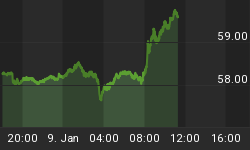Let us clarify that we do our best to take the emotional element out of our trading decisions and we do not "worry" about our investments. Instead we pay especially close attention to the markets and our investment decisions at critical junctures. But for expediency we will use the term "worry" in this article.
So when is it time to worry? It is our opinion that an investor should pay close attention and possibly "worry" when truly unusual market behaviors, or "anomalies", take place.
For Example:
Imagine you are holding a coin in your open palm, with a straight arm at shoulder height. Now imagine turning your hand to the side to let the coin fall. Naturally the coin would drop to the ground as the laws of physics pull it towards the earth. Now on the other hand, how would you feel if you turned your hand and the coin went up? Sounds ridiculous doesn't it? The point of this analogy is that you would probably have very good reason to be concerned. It is our opinion that most people would probably really "freak out" and we think it would be fully justified.
So how does this apply to the financial markets of today? Are we experiencing "unusual" or "normal" market behavior when it comes to precious metals such as silver. The following chart shows us what has happened to the price of silver, in US dollars, since the start of the bull market.

In the above chart you will notice a few things.
-
As with all markets you should note that the price does not move in a straight line. Although we are in a major bull market the price has times of bursting forward along with investor enthusiasm and falling back due to pessimisms. In our opinion this is normal market behavior and nothing to be alarmed about.
-
Next you should note that so far in this bull market the price has had two very prominent advances. From June 2004 to nearly April 2004 silver surged from under five dollars per ounce to over eight dollars. From August 2005 the price moved from under nine dollars to over nearly fifteen dollars in May of 2006. We shaded these areas in green.
-
Notice how the price of silver will pull back from a significant advance and then consolidate for a number of months. We shaded these areas in red. In a bull market this necessary price action is what causes investors to lose enthusiasm, give up hope, and sell out of positions. This is when negative commentary and analysis is prevalent and doubts abound that the bull market is ending.
-
Finally, in the above chart, observe generally what has happened to the price of silver in the month of June. Notice how June has seasonally been a very weak month for the price of silver. However, investors sometimes forget that in a bull market weak prices usually mean a great buying opportunity. Notice what has happened to the price of silver following the seasonally weak late spring and summer months.
At this point we must remind you that just because the price has behaved one way in the past it does not necessarily mean it will do so in the future. The markets seem to have a funny way of changing right when an investor gets comfortable with a certain pattern. However, at this point we do not see reason for concern.
In 2006 silver and gold had a major advance followed by significant correction. In our opinion this healthy correction appears to be following a normal pattern. We are currently in late spring heading into summer, the months where the metals price seems to regularly soften. We are predictably hearing bearish commentary and news about how poorly silver and gold have been performing and why it may drastically fall. In our opinion all of these market observations are normal, healthy and bullish for the price of silver and gold.
So when should an investor worry? We can say that right now, we are not worried about our investment decisions. Please watch for part two of this commentary on this website. You may also visit our website www.investmentscore.com to subscribe to our free investment newsletter for notification of articles such as this one. At www.investmentscore.com you can also learn about our unique investing system and custom built timing charts. We hope to see you there.
















